By the outbreak of war in 1914, heavy naval shells had reached approximately the form they would take for the next three decades. Heavy armor-piercing (AP) shells, equipped with caps designed to prevent them from shattering on impact with face-hardened armor, could carry small quantities of explosives, 1-2% of shell weight, through armor plate and detonate on the other side. Other shells, often known as common, carried much more explosive, but were fuzed to detonate on impact, or possibly after piercing a much thinner armored plate. But there was plenty of room for variation on these themes, and some nations had done a much better job than others at anticipating the demands of war.
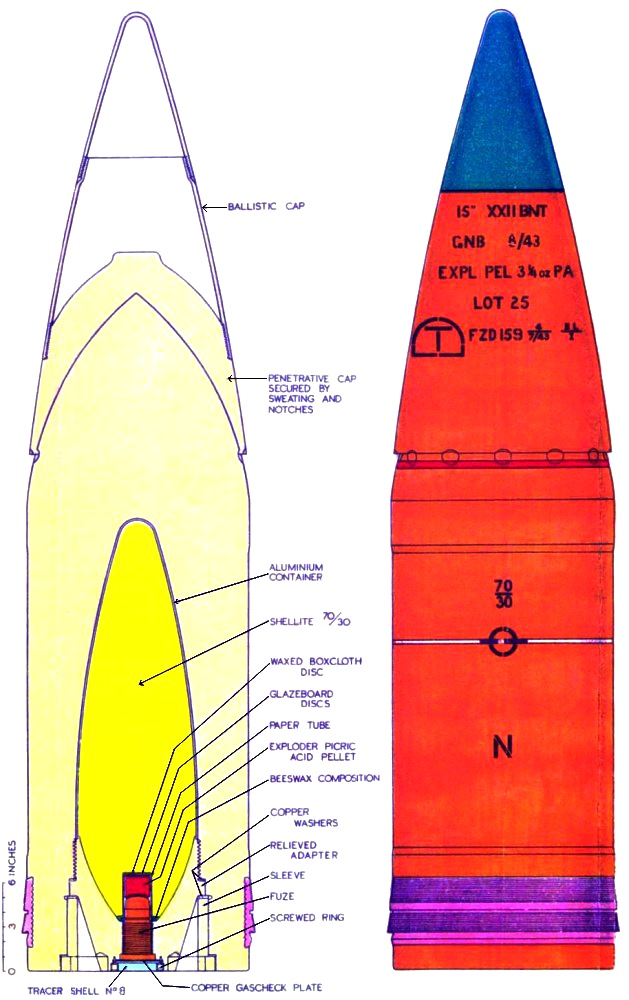
A British 15" AP shell of 1943
The British in particular had badly misjudged how their shells would be used in action. They had based much of their doctrine around long-range engagements with common shells, intended to destroy the enemy's unarmored upperworks, start fires and demoralize the crew, with AP shells to be held for finishing off enemy ships at closer range. This was used as a justification for not carrying out oblique impact tests on their AP projectiles, which turned out to be a serious mistake at Jutland, where few projectiles penetrated heavy German armor. Action was quickly taken to address this, and in 1918, a new shell, known as the Greenboy from its paint scheme, was issued to the fleet. It had a new, much harder, AP cap and a redesigned body for better penetration, particularly during oblique impacts, while an improved delay fuze and a new explosive, shellite, would allow it to penetrate armor and reach the ship's vitals in a fit state to burst.
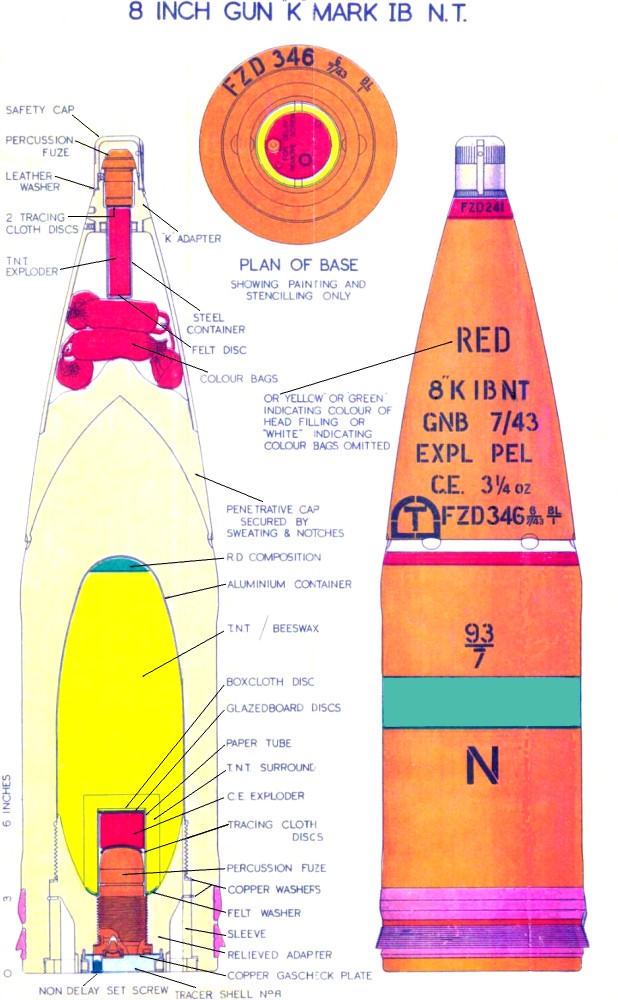
A British 8" shell showing the dye marker system
In the aftermath of WWI, all of the various powers continued their shell development program, gradually refining the shape, metallurgy, and heat treatment of their shells to improve penetration. As "all-or-nothing" armor schemes became common, the various common-type shells fell into disuse, leaving battleships armed with AP and maybe a high-explosive/high-capacity shell for shore bombardment. A typical WWII-era AP shell could penetrate armor about 40% thicker than an immediate postwar shell of the same caliber. One important innovation during this era1 was the use of dye markers to make spotting easier when multiple ships were firing on the same target. The dye packet was usually underneath the windscreen, which was often modified with vents to allow the dye to flow out and color the shell's splash. Each ship within a squadron would be assigned a different color, allowing its splashes to be distinguished.
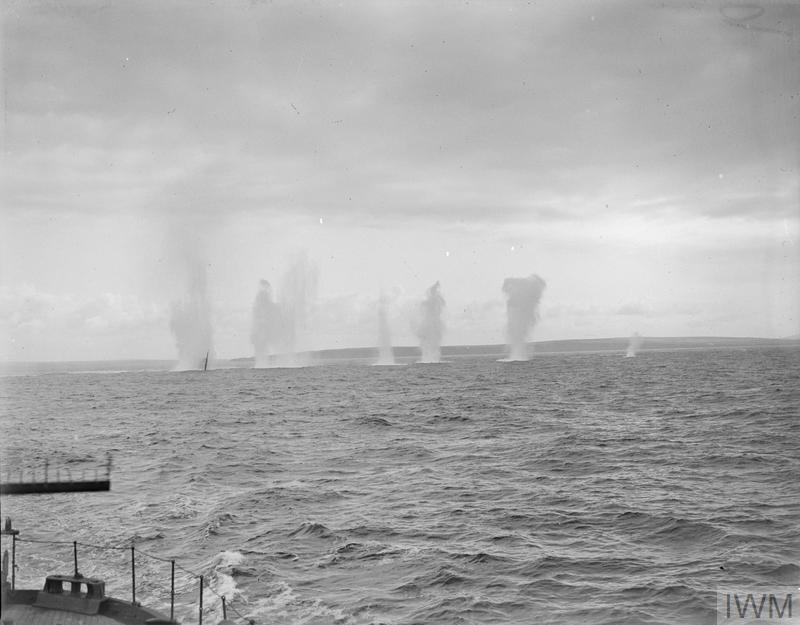
Shell splashes rise during gunnery training.
While the general trend of shell procurement after WWI was fairly conservative, there were a few exotic ideas that made it off the drawing board. In the US, the gas shell was developed, a standard AP shell where 25% of the filler was replaced by some form of gas, which would be released inside the ship. Both the USN and RN took the threat of such shells very seriously in the interwar years, although none of them ever saw action. British experiments with thermite fillings for incendiary purposes were unsuccessful, and the idea was quietly shelved.
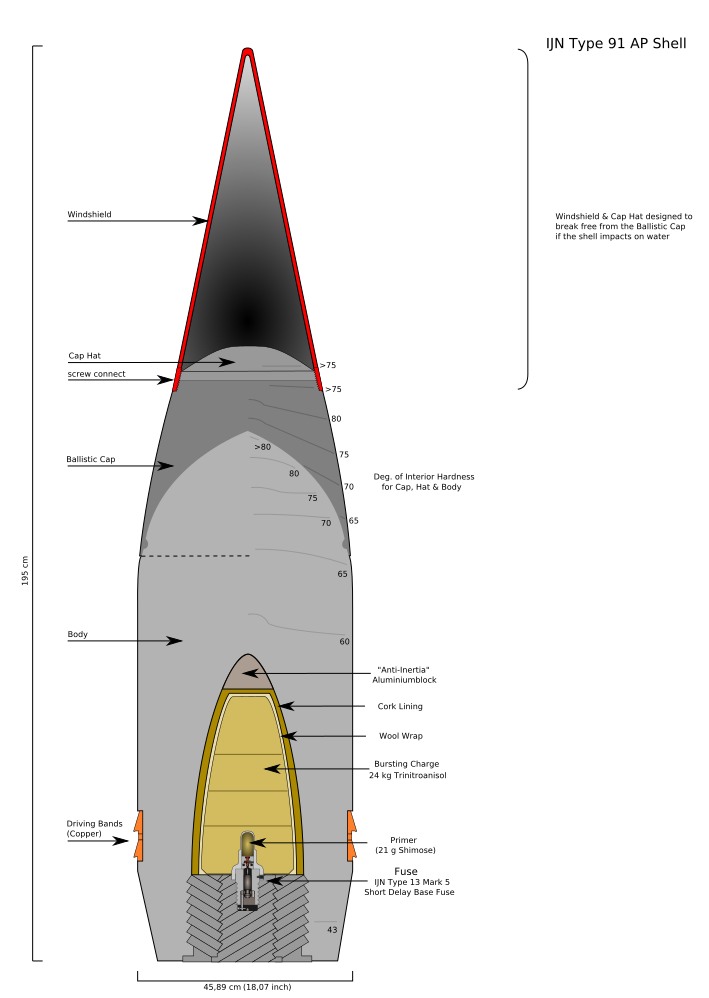
A diagram of the Type 91 AP shell
The only nation to make a radical departure from the general trend of shell development in the interwar years was Japan. In 1924, during a test on the battleship Tosa, cancelled under the Washington Naval Treaty, one shell, striking 25m short, ran under the water and penetrated the hull under the belt, detonating in the engine room and doing extensive damage. The Japanese seized on this method of attack, and developed an armor-piercing projectile, the Type 91, optimized for underwater hits.2 It was a very long shell, as part of a separate Japanese plan to outrange the American fleet, with a windscreen designed to break away when the shell struck the water. This left a flat face on the AP cap, which gave better stability underwater.3 Optimizing the shell for underwater hits made it somewhat less effective at penetrating armor, but the biggest compromise was in the area of fuzing. While a normal AP shell might have a delay of 0.02-0.05 seconds, the Type 91 used a delay of .4 seconds. This meant that when fired against lightly-armored targets, the Type 91 tended to penetrate out the far side of the vessel before it went off. There were several other drawbacks. First, the range had to be fairly great, so that the shell was falling steeply enough to pass under the belt before it lost too much speed. Second, the technique was not practiced due to secrecy, and these hits proved to be vanishingly rare in action. The only example was during the Battle of Cape Esperance, when a single 8" shell reached the forward magazine of the light cruiser Boise. This was exactly the kind of hit the Japanese had wanted, but the resulting fire was quenched almost immediately by the flooding from the breach the shell had made in the hull.4
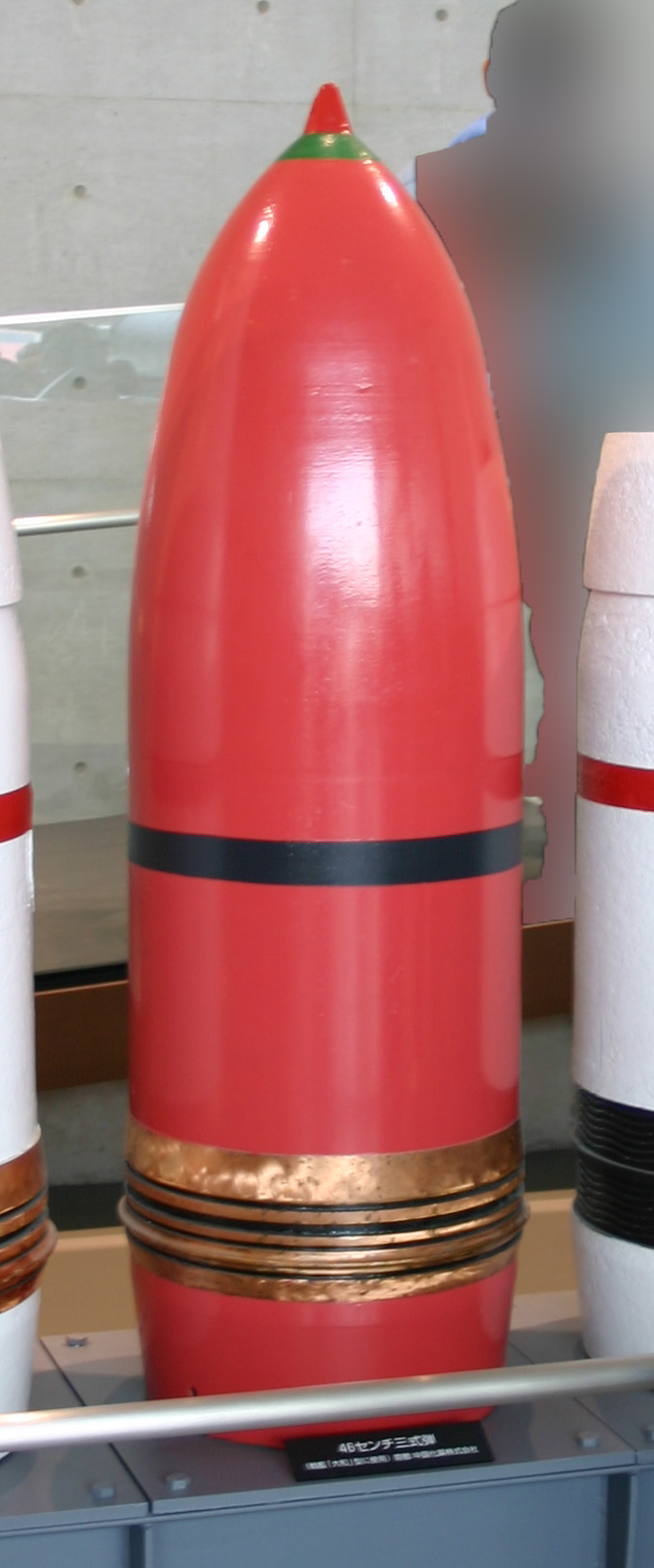
A Type 3 Sanshikidan
Nor was the Type 91 the only unusual projectile the Japanese developed. While most countries gave their heavy guns a theoretical AA capability through the use of time fuzes on high explosive (HE) shells and special range tables,5 the Japanese developed a specialized AA shell for their heavy guns, the famous Type 3 Sanshikidan. It was loaded and fired like a regular shell, with a time fuze, set before the shells went up the hoists, to set off the bursting charge. When that happened, hundreds of small tubes filled with an incendiary compound were released, each spouting a 16' flame for the next 5 seconds. In theory, each 18.1" incendiary shrapnel shell from Yamato could produce a burst radius of 397', as opposed to 223' for the HE shell, although both values are probably high. A salvo of these shells, which could take up as much as 40% of a Japanese battleship's magazines by the end of the war, was supposed to create a barrier for attacking aircraft, but American pilots considered them much more effective for creating light shows than for doing damage.6
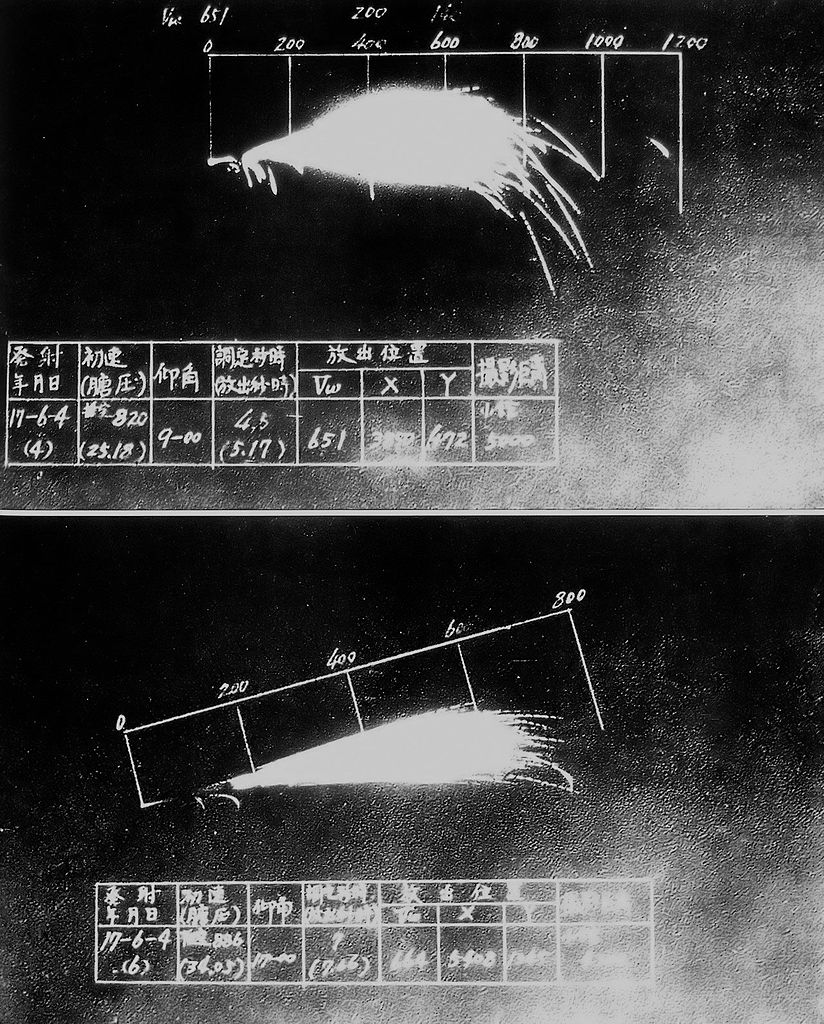
A Sanshikidan projectile in action
Of course, there's one nation that I haven't mentioned in all of this, a nation that made the greatest strides in heavy naval shells, and kept developing them decades later. Next time, I'll discuss the USN's shells from the 1930s and onward.
1 Originally made by the French, and transferred to the British in 1939 in return for Asdic. The Americans and others may have developed the technology independently. ⇑
2 Interestingly, the French had looked into underwater hits as a means of attack during the years leading up to WWI, although they were unable to come up with an effective projectile, and appear to have abandoned the concept after the war. ⇑
3 Basically, a pointed nose gave any overturning force a longer lever, so the shell would tumble and lose velocity faster. ⇑
4 Another odd feature of these shells was the use of Trinitroanisole as the bursting charge. This was more powerful than most other options, but required a lot of cushioning to keep it from going off on impact, to the point that they probably would have been better off with TNT. ⇑
5 In practice, of course, this capability was next to useless. The time fuzes would have to be set manually, and shooting at a fast-moving target using a paper range table (like this one for the 16"/50s of Iowa) would be an exercise in futility. Heavier guns were occasionally used against torpedo bombers by firing into the sea ahead of them, hoping to raise splashes that might bring down the low-flying airplanes. Tirpitz actually attempted to do this during WWII, and the British made use of battleship-caliber guns in the AA role on several occasions during WWI. Monitors used shrapnel shells both to defend London against Zeppelins and to protect themselves against fixed-wing aircraft off the coast of Belgium. At Jutland, several battleships fired their main guns against a German Zeppelin, although I'm not sure what shells they used. ⇑
6 These shells were also used during the bombardment of Henderson Field, and a few were used against ships during the opening phase of the First Naval Battle of Guadalcanal before the Japanese managed to get AP shells up from the magazines. ⇑

Comments
So, the bit where the British were going to start by tearing up the enemy's ships with long-range HE/common shell - how did that work out in practice, or did they just change their mind and not even try by the time WWI came around?
It worked quite well in the Russo-Japanese War. Wasn't really attempted in WWI, probably because of changes in ship design. Pre-dreads had lots and lots of their firepower exposed in the form of the secondaries. This wasn't true during the dreadnought era. All the important bits were armored anyway, so you pretty much had to go with AP. At Jutland, almost everything the British fired was AP or SAP.
Bean, You mentioned the British general shell crisis being an issue in the attack on the Dardanelles. Is this what you meant, that the naval APs were in short supply and didn't work?
Pretty much. There were two problems during the bombardment of the Dardanelles. First, the shells didn't work that well. Lots of duds and partial detonation, poor fuzing for bombardment work, etc. Second, there weren't enough of them. The British had only bought enough real shells for a full load for each ship, plus a reserve of IIRC 30-40%. (Skimping on ammunition in peacetime isn't a modern invention.) In fairness, their fleet was expanding rapidly, and they probably thought there would be time to build more shells if war broke out. The problem was that the Army in France needed way more shells than it was getting, so the Navy wasn't going to be able to replace any they fired at the Turks very well. This wasn't the end of the world because they had a bunch of pre-dreadnoughts with obsolete guns, but it did mean they couldn't simply drench the Turks in high explosives.
(Also, have you been reading ahead? That post isn't going live until the end of the month.)
"Pre-dreads had lots and lots of their firepower exposed in the form of the secondaries. This wasn’t true during the dreadnought era."
I would argue that dreadnought-era ships had lots and lots of their effective firepower exposed in the form of rangefinders and directors, with less armor than secondary-gun casemates and more vulnerable to being smoked out or burned out from below. More generally, the list of dreadnought battleships substantially degraded or outright mission-killed by hits that didn't penetrate the citadel is not small.
If the British had designed their battleship armament for maximum effectiveness with HC shell at long range and AP at close range, then they might have done better to stick with that until they could redesign the AP shells.
I take it this is because of depletion of normal shells and not because of deliberately increased emphasis on the incendiaries?
On one hand, you’re not wrong, and the British screwed up their shell procurement by the numbers. On the other, I strongly suspect this was nowhere near as apparent to them as it is to us, with the benefits of both hindsight and a much broader view of the situation. Keep in mind just how fast technology was changing in this period. Only a handful of battleships had directors at all when war broke out, and it wasn’t entirely clear that that was the way of the future. The shell standards were set a few years before that, and nobody seems to have thought to revise them. (This wasn’t a problem unique to the British, either. The Germans did something very similar in WWII.) Also, a lot of the British shells were SAP, although they were really close to British AP in penetration.
I would sort of question the theory that dreadnoughts are as vulnerable as pre-dreads. Yes, it's possible to mission-kill one without citadel penetration, but a lot of those involved things like turret hits, which are a lot more effective coming from an AP shell than an HE shell. For that matter, dreadnought battles of any kind didn't happen before 1914, and after 1914, the British were too busy to redesign their AP shells.
@ADA
What depletion of normal shells? The only time the Japanese battleships fired normal shells in the later half of the war was at Samar. And they didn't fire nearly enough to do that. The Japanese liked the Type 3, but they were awful about overclaiming shot-down aircraft.
"Also, a lot of the British shells were SAP, although they were really close to British AP in penetration."
Presumably because the British AP was breaking up whenever it hit heavy armor at an angle, giving it the same weakness as SAP without the compensatory doubled or trebled explosive content.
Did the SAP have reliable fuzes, or were they mostly duds? I mean, almost every type of shell fired from battleships in that era seems to have been mostly-duds in practice, so I know where to bet. But SAP or base-fused HE that works would have been ideal for what the British were apparently aiming for and probably a pretty good dreadnought-wrecker overall.
The fuze problems were common across all British base fuzed shells.
The other thing to note is that statistical quality control was not even in its infancy in the 1900-1914 period; the British testing protocol (grab a few random shells from the lot, test one, if it failed test another, if any of them worked, pass the lot) was so inadequate that a statistician who looked at it decided that a lot that was more than 50% bad would probably pass the test.
First, let me point out that I have another post on the shell problem at Jutland in particular, and everyone keeps stealing my points.
The problem was worse than just bad statistical control. If a batch failed, the manufacturers would start claiming special circumstances and trying to get the navy to buy it anyway.
Kinetic energy, a 1 ton shell with a hardened armor piercing tip does not blast its was through armor plate. The shell traveling at something like 2,000 fps [FEET PER SECOND], has an incredible kinetic energy striking proper angle, striking at a proper angle, that will punch a hole through the armor plate.
Well 'big deal' in some ways. With the shell staying intact it would just about punch a hole about the same size as the hole in arrived in. The subtle thing about all this is the shell is carrying explosives. How many pounds do you think, 500, 800, more, less? About 35 pounds actually.
So now we have a 2,000 pound shell traveling at 2,000 feet per second piercing the armor plate of an opponent. Maybe the shell has dropped down to 1,600 fps - it is still in tack and only threatening the 16 inches in front of it.
It is worked out that the explosives in the shell delay exploding in what we now call micro seconds. With the shell speeding along a very small explosion now breaks up the shell from the inside. 50 pound, 800 pound, and all sorts of ragged steel is now flying around in many directions inside the ship. Once inside the ship these very high speed chunks are what causes all sorts of serious damage.
This is an extremely well done site.
Japanese 'bombardment shells' are excellently explained. Henderson Field on Guadalcanal was bombarded with them numerously and the airfield was back in operation within hours afterwards. These big 'shotgun' shells did not blast 40 foot deep 50 foot wide holes in the runway or surrounding area. Had the Japanese used their HE shells, whether from a cruiser or battleship, the runway area would look like the face of the moon.
Now HE shells work in much the way armor piercing shells except they are designed to explode on contact. A Japanese shell weighing in the 1,600+ pound range, traveling at roughly 1,800 feet per second, meeting no resistance, for mud offers none, the shell goes deep and when it does explode the mud will travel upwards leaving a large hole.